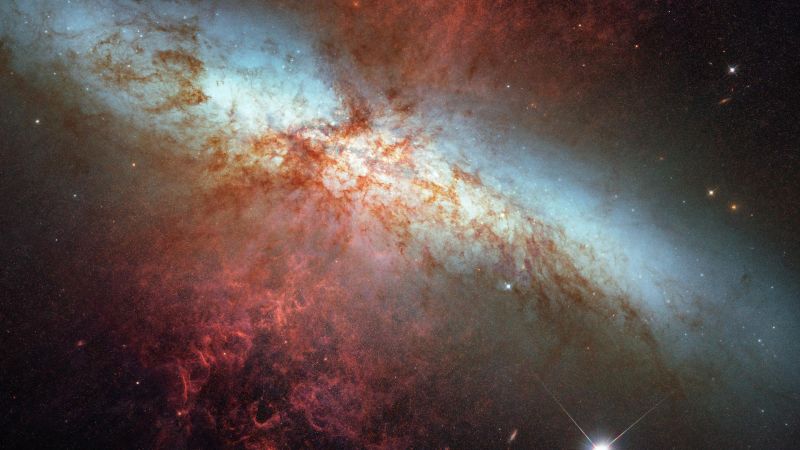In recent research, scientists have proposed an intriguing theory suggesting that violent supernovas might have been responsible for two of Earth’s largest mass extinctions, previously lacking sufficient explanation. This research sheds light on cosmic events that could potentially affect life on our planet, raising questions about the interconnectedness of the universe and Earth’s geological history. The study, which appears in a recent issue of the “Monthly Notices of the Royal Astronomical Society,” has generated excitement within the scientific community regarding the relationship between stellar phenomena and biological evolution on Earth.
As massive stars reach the end of their life cycles, they undergo dramatic transitions where their core collapses, ultimately resulting in an explosive outburst known as a supernova. This cataclysmic event not only annihilates the star itself but also releases prodigious amounts of material and radiation into space. Such explosions could significantly perturb the interstellar environment, leading researchers to consider their potential effects on nearby celestial bodies, including Earth.
The research team undertook a comprehensive analysis of the supernova rates among stars located within a relatively close vicinity to the Sun, specifically those within a distance of 65 light-years. Their calculations estimated that approximately 2.5 supernovas could influence our planet over the span of a billion years. This finding implies that there would have been one or two supernovas that may have impacted Earth during the last 500 million years, a period characterized by significant biological evolution. These findings have prompted discussions among scientists about the likelihood of these cosmic events being linked to the mass extinction events that have occurred on Earth.
Co-author Nick Wright, a lecturer in physics and astrophysics at Keele University, indicates that the results suggest a lower rate of destructive supernova occurrences than previously believed. This realization has opened up possibilities for deeper exploration of how such cosmic incidents might relate to the extinction events that have occurred throughout Earth’s history. Over the last 500 million years, there have been five major extinction events where a vast majority of species—both terrestrial and marine—disappeared over relatively short geological spans.
This theory posits that supernova explosions could introduce detrimental effects on the planet’s atmosphere, including the potential depletion of the ozone layer. Such degradation could expose life on Earth to harmful radiation, triggering a cascade of ecological consequences that might lead to mass extinction incidents. Notably, the research suggests that supernovas could have contributed to the Late Devonian extinction event, which occurred roughly 372 million years ago, and the Late Ordovician extinction event around 445 million years ago.
Life on Earth was thriving during the Devonian period, marking the emergence of early land plants and animals, but these organisms faced catastrophic declines due to environmental shifts possibly instigated by nearby supernova activity. Similarly, the end of the Ordovician period saw dramatic species loss, with nearly 85% of existing species vanishing from the Earth primarily confined to aquatic ecosystems at that time. The research draws connections between such mass extinctions and the potential climatic effects induced by supernova proximity, such as glaciation, echoing theories from several paleontologists.
While the researchers did not provide concrete evidence linking supernovas to these extinction events, they highlighted hypotheses that suggest the catastrophic impacts of nearby stellar explosions. Scholars in the field, including Mike Benton from the University of Bristol, emphasize the need for a better understanding of the chronology of geological and astronomical events. They call for calibrating the timing of supernova explosions in relation to known mass extinction events to strengthen the evidence for potential links.
Other scientists, like Paul Wignall from the University of Leeds, expressed interest in this theory but reinforced that empirical evidence is crucial to support these claims. Proposed markers in the geological record, such as exotic elements produced in supernova explosions, could provide valuable insights into tracing the impacts of these cosmic events on Earth.
Moreover, researchers have established that massive celestial impacts, such as the well-documented asteroid strike that occurred about 66 million years ago off the coast of present-day Mexico, were responsible for the demise of the dinosaurs and many other species. This raised the question of whether evidence for supernova-induced extinction might surface through similar geological findings.
In summation, while this research presents a fascinating perspective on the potential effects of supernovas on Earth’s biosphere, it is essential to approach these findings with caution. The study ultimately seeks to highlight the intricate ties between cosmic events and life on Earth, fostering further investigation into the historical relationship between the universe and our planet’s evolutionary narrative. The quest to uncover the causes of mass extinctions continues to evolve, with researchers diligently striving to piece together the complex puzzle of life’s history on Earth.












